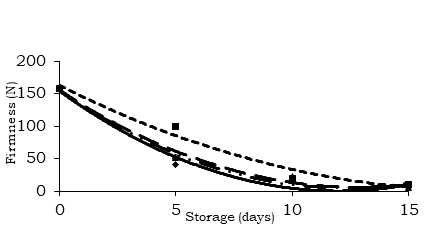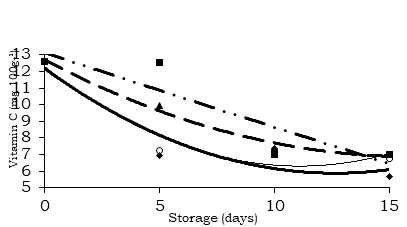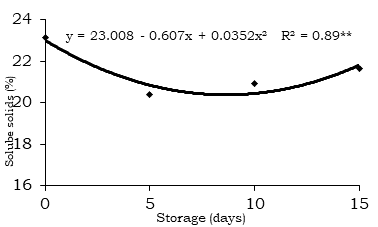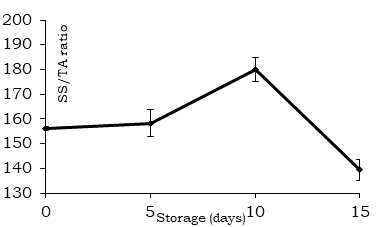Potassium permanganate effects on the quality and post-harvest conservation of sapodilla (Manilkara zapota (L.) P.Royen) fruits under modified atmosphere
DOI:
https://doi.org/10.15446/acag.v66n3.54579Palabras clave:
Ethylene, fruit quality analysis, physiological maturity, postharvest conservation, storage time (en)Ethylene, fruit quality analysis, physiological maturity, postharvest conservation, storage time (pt)
Descargas
Sapodilla (Manilkara zapota (L.) P. Royen) is a climacteric fruit, very perishable, with high metabolic activity, rapid ripening and reduced storage time at room temperature, thus making difficult its commercialization. However, this research aimed to evaluate the effect of potassium permanganate (KMnO4) on the quality and post-harvest conservation of sapodilla fruit under modified atmosphere at room temperature. The sapodilla fruits were harvested when they reached physiological maturity and then accommodated in Styrofoam trays with PVC film coating. Within each package, KMnO4 were placed at different concentrations (0, 0.250, 0.375, and 0.500 g of KMnO4 per kg of fruit, respectively), impregnated in vermiculite. In addition, were kept in storage at room temperature (25 ± 1 °C and 54 ± 5% RU) for fifteen days, with fruit quality analysis every five days. The potassium permanganate doses influenced the sapodilla fruit quality, wherein the concentration of 0.375 g of KMnO4 per kg of fruit was the most efficient, retarding the loss of firmness and vitamin C degradation of sapodilla fruits throughout five days storage under modified atmosphere at room temperature. The sapodilla fruit postharvest life stored under modified atmosphere with potassium permanganate 25 ± 1 °C and 54 ± 5% RU, is ten days.
Recibido: 8 de diciembre de 2015; Aceptado: 14 de junio de 2016
Abstract
Sapodilla (Manilkara zapota (L.) P. Royen) is a climacteric fruit, very perishable, with high metabolic activity, rapid ripening and reduced storage time at room temperature, thus making difficult its commercialization. However, this research aimed to evaluate the effect of potassium permanganate (KMnO4) on the quality and post-harvest conservation of sapodilla fruit under modified atmosphere at room temperature. The sapodilla fruits were harvested when they reached physiological maturity and then accommodated in Styrofoam trays with PVC film coating. Within each package, KMnO4 were placed at different concentrations (0, 0.250, 0.375, and 0.500 g of KMnO4 per kg of fruit, respectively), impregnated in vermiculite. In addition, were kept in storage at room temperature (25 ± 1 °C and 54 ± 5% RU) for fifteen days, with fruit quality analysis every five days. The potassium permanganate doses influenced the sapodilla fruit quality, wherein the concentration of 0.375 g of KMnO4 per kg of fruit was the most efficient, retarding the loss of firmness and vitamin C degradation of sapodilla fruits throughout five days storage under modified atmosphere at room temperature. The sapodilla fruit postharvest life stored under modified atmosphere with potassium permanganate 25 ± 1 °C and 54 ± 5% RU, is ten days.
Key words:
Ethylene, fruit quality analysis, physiological maturity, postharvest conservation, storage time.Resumo
O sapoti (Manilkara zapota (L.) P. Royen), é um fruto climatérico, muito perecível, com elevada atividade metabólica, rápido amadurecimento e tempo de conservação reduzido sob temperatura ambiente, dificultando assim a sua comercialização. No entanto, este trabalho teve como objetivo avaliar o efeito de sachês de permanganato de potássio (KMnO4) sobre a qualidade e conservação pós-colheita do fruto de sapotizeiro sob atmosfera modificada em temperatura ambiente. Os sapotis foram colhidos ao atingirem a maturidade fisiológica e em seguida acomodados em bandejas de isopor com revestimento de filme PVC. No interior de cada embalagem, foram colocados sachês de KMnO4 em diferentes concentrações (0; 0,250; 0,375 e 0,500 g de KMnO4 por kg de fruto), impregnado em vermiculita. Em seguida realizou-se o armazenamento a temperatura ambiente (25 ± 1 ºC e 54 ± 5% UR) por um período de quinze dias, sendo realizadas análises de qualidade dos frutos a cada cinco dias. As doses de permanganato de potássio influenciaram na qualidade dos frutos de sapotizeiro, sendo que a concentração 0,375 g de KMnO4 por kg de fruto foi a mais eficiente retardando a redução da firmeza e degradação da vitamina C dos frutos até cinco dias de armazenamento sob atmosfera modificada e temperatura ambiente. A vida útil pós-colheita de frutos de sapotizeiro armazenados sob atmosfera modificada com sachês de permanganato de potássio, sob condições ambientais de 25 ± 1 ºC e 54 ± 5% UR é de dez dias.
Palavras-chave:
Análise de qualidade de frutos, conservação pós-colheita, etileno, maturidade fisiológica, tempo de armazenamento.Introduction
Sapodilla (Manilkara zapota (L.) P. Royen), is a climacteric fruit, very perishable, with high metabolic activity, rapid ripening and reduced shelf life at room temperature (Oliveira et al., 2011), due to substrates content favoring the proliferation of pathogenic organisms, moisture, organic acids and sugars, leading to a higher decay probability and limits the fruit conservation and marketing. Given these concerns, sapodilla is a fruit, which have the highest consumption in fresh form, it is necessary to establish post-harvest conservation techniques to extend the fruit shelf-life.
It is important to note that in postharvest, fruit conservation with a modified atmosphere is suggested as an important technology for reducing water loss, and provides other desirable effects such as firmness and color maintenance by changing the gas composition surrounding the fruit (Oshiro et al., 2013).
Furthermore, the package under modified atmosphere, retards the growth of pathogenic and spoiling micro-organisms, from the decrease of the partial O2 pressure and an increase in CO2, which has an inhibitory effect on bacterial growth (Mantilla et al., 2010).
However, even under these conditions, ripening or loss of quality can be accelerated due to the action of ethylene. Thus, for prolonged storage, other storage techniques such as the use of potassium permanganate can complement the effects of the modified atmosphere and maintain good fruit quality.
Control of ethylene and its effects on fruit ripening provides more accurate and reliable estimates of fruit harvest at the pre-climacteric stage and storing them in an environment which contains products able to remove this phytohormone (Amarante & Steffens, 2009). Potassium permanganate (KMnO4), is an ethylene absorber being used in the form of sachets or impregnated in plastic containers or in chemical filters, which absorb and oxidize ethylene to water, carbon dioxide, manganese dioxide and potassium (Wills & Warton, 2004).
Alternatively, studies have shown the use of potassium permanganate for ethylene removal retards the ripening of various climacteric fruits such as banana (Prill et al., 2012), papaya (Silva et al., 2009b) and apple (Amarante & Steffens, 2009). Specifically, for sapodilla more studies are carry out only with modified atmosphere, inhibitor synthesis and ethylene action. Costa et al. (2011), observed the use of corn starch at 5%, reduced pulp loss and increased the shelf-life of sapodilla. Morais et al. (2008), studying with 1-MCP in the cell wall biochemistry of sapodilla found that 1-MCP, delayed the sapodilla softening for 11 days.
In the literature there is still little research with this species, related to the use of ethylene absorbers, such as potassium permanganate. Thus, this study aimed to evaluate the effect of potassium permanganate on the quality and post-harvest conservation of sapodilla fruit under modified atmosphere at room temperature.
Materials and methods
Sapodilla fruits used in this experiment were collected from a commercial plantation in the Norfruit Ltda. farm, located 7 km northeast of the km 36 of the BR 304 highway, Pau-Branco community, in Mossoró-RN, at south latitude 5º 11' and a west longitude 37º 20' and an altitude of 18 m.a.s.l. The cultivar used was 'Itapirema-31', whose seedlings for orchard installation were obtained from the Pernambuco Agricultural Research Company (IPA). The sapodilla with marketing standards (average weight of 120 g and an average size of 59 cm long and 63 cm in diameter) were harvested when reaching commercial maturity in May, 2010. Shortly after, they were transported to the laboratory of postharvest fruit physiology of the UFERSA- Universidade Federal Rural do Semi-Árido, Brazil. in vitro conditions, a selection of fruit was carried out by the degree of ripeness, shape and size. They were washed, dried and accommodated in Styrofoam trays with PVC film coating, four fruits per tray. Inside each package were put sachets of KMnO4 impregnated in vermiculite. The KMnO4 concentrations used were as follows: 0; 0.250; 0.375 and 0.500 g of KMnO4 per kg of fruit, respectively. Sapodilla fruits were kept in storage at room temperature (25 ± 1 ºC and 54 ± 5% RU).
It was used a completely randomized design in a split plot design, with the treatments (doses of potassium permanganate) and the subplots were defined as storage time (0, 5, 10 and 15 days) in plots.
The evaluation of the external appearance was performed with a subjective scale according to Miranda et al. (2003), with some modifications taking into account the impact spots, fungal infection and wrinkling. The scores ranged from 1 to 5, based on the percentage of affected fruit as follows: 1) absence of symptoms; 2) 1 to 15%; 3)16 to 30%; 4) 31 to 45%; and 4) over 45% of fruits affected. Fruit with notes above 3.0, were considered unsuitable for marketing. In the evaluation of internal appearance, it was used a subjective scale, in which the scores ranged from 1 to 5, based on the percentage in the affected pulp area as follows: 1) no symptoms; 2) 1 to 15%; 3) 16 to 30%; 4) 31 to 45% and 5) over 45% of pulp affected, considering the stain incidence and mold attack. Therefore, analysis of color content in pulp fruit was carried out using a subjective scale of notes 1 to 4, where: 1) corresponds to light cream pulp; 2) dark cream; 3) light brown; and 4) dark brown. To determine the fruit firmness it was used a McCormick penetrometer, model FT 327, and the results were expressed in Newton (N). The weight loss was determined by the difference of the initial and final mass and expressed as a percentage. The electrolyte leakage was determined by using a blade to remove 2 cm disks from the bark of the median region of each sapodilla fruit for all replicates. Additionally, were transferred into test tubes containing distilled water at room conditions, where they remained for two hours. Once the resting time was over, the solution electrical conductivity was measured with a Schot conductivitymeter model CG 853. Subsequently, the test tubes containing the peeling discs were autoclaved (121 °C at 1.5 atm) for 30 minutes and the electrical conductivity measured again. The results were expressed in obtained percentage from the ratio between the first and second measurement values, multiplied by 100.
The amounts of vitamin C were determined immediately after fruit processing by means of titration with a DFI solution of (2,6-dichloro phenol indophenol 0.02%) until obtaining a permanent pink coloration. The titratable acidity (TA) was determined by pulp titration with solution of NaOH at 0.1 M, according to the AOAC method (2005), expressed in percentage of malic acid. The pH measurements were determined with the aid of a pHmeter with a measurement directly performed on processed pulp (AOAC, 2005). For the determination of soluble solids (SS, %), fruit pulp was filtered through filter paper and the soluble solids content measured in digital refractometer Atago(r) PR-101 Pallete model, according to the AOAC method (2005), with automatic temperature compensation. Determination of soluble sugars, readings in a spectrophotometer at 620 nm and results expressed as % of glucose.
The results were submitted to variance analysis using the Sisvar 4.6 software (r). For mean comparison, we used the Tukey and Kruskal Wallis test at 5% of significance (p<= 0.05) and regression analysis for the quantitative factor.
Results and discussion
There was interaction between the evaluated factors, potassium permanganate doses and storage time for vitamin C and fruit firmness. For external and internal appearance, pulp color, titratable acidity, pH, soluble solids, soluble solids/titratable acidity ratio, total soluble sugars, weight loss and electrolyte leakage variables, was observed significant effect only for storage.
The loss of fruit weight reached about 20% after 15 days of storage, which compromised the fruit appearance which became wrinkled (Table 1).
* Means followed by the same letter in the column do not differ by ¹Tukey and ²Kruskal-Wallis test (p<0.05). CV= coefficient of variation.Table 1: Mean values for weight loss (WL), electrolyte leakage (EL), external appearance (EA), internal appearance (IA) and pulp color (COLOR) of sapodilla (Manilkara zapota (L.) P. Royen) subjected to treatment with potassium permanganate under modified atmosphere permanganate and stored at room temperature (25 ± 1 °C and 54 ± 5% UR)
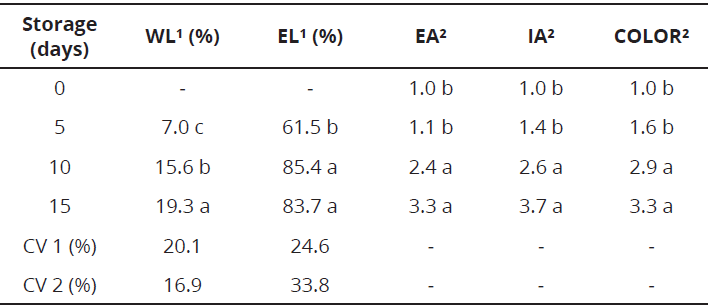
The increase in mass loss is the result of an accelerated metabolism due to low relative humidity and high temperature at which, sapodilla fruits were submitted during storage.
Miranda et al. (2003), evaluating sapodilla storage for 12 days at room temperature (24 ± 2 °C and 90 ± 5% RU) obtained mass loss of approximately 9% lower than obtained in this research, presumably due to higher rate of relative humidity, which provided a reduction in fruit transpiration, which is the main factor and is associated with the difference in water vapor pressure, thereby reducing water loss from the fruit.
In addition, for electrolyte leakage variable, there was a significant increase in storage time (Table 1), which coincided with the climacteric rise, indicating a loss of integrity (selective permeability) of the cellular membrane system, possibly caused by the early senescence. The changes in the membrane functionality are the result of the decrease in lipid fluidity and structural change, and the decline of membrane proteins during senescence. The increase of electrolyte leakage in fruits during the storage time was also observed in banana peel at room temperature (Maia et al., 2011) and papaya Sunrise Golden cultivar (Silva et al., 2009b).
Sapodilla fruits, performed good appearance until 10 days of storage, but at 15 days in all treatments, the fruits were inadequate for marketing, reaching notes above 3.0 for external and internal appearance (Table 1). The Fruit appearance was compromised by fungus growth in some fruits, as well as the high mass loss and electrolyte leakage of cell wall, which have allowed the storage time decreased left them wrinkled finally.
The fruit acceptability by consumers is primarily determined by their appearance. Morais et al. (2006a), evaluating sapodilla fruits subjected to treatment with 1-methylcyclopropene, stored under modified atmosphere (25 ± 2 °C and 70 ± 5% UR), observed lifespan of 21 days, being higher than found in this research. This information is useful because provides more accurate and reliable estimates of treatment with 1-methylcyclopropene (ethylene action inhibitor) is more effective than potassium permanganate.
There was a significant development of pulp coloring with time of storage in which, went from pale cream to light brown (Table 1). The peel color change and fruit pulp after harvest may have an enzymatic origin, involving the participation of certain enzymes such as phenylalanine ammonia-lyase involved in anthocyanin synthesis and other phenolic (Edahiro et al., 2005).
Throughout the storage, there was a clear decrease in fruit firmness, more pronounced for control treatment (Figure 1).
Figure 1: Firmness of sapodilla (Manilkara zapota (L.) P. Royen) subjected to treatment with potassium permanganate under modified atmosphere and stored at room temperature (25 ± 1 °C and 54 ± 5% UR)
Although, for fruits treated with potassium permanganate, the firmness reduction was delayed, with an observed more efficient result for the dose of 0.375 g until the fifth day of storage (Table 2).
* Means followed by the same letter in the column do not differ by Tukey test (p<0.05). LSD= least significant difference.Table 2: Mean values of pulp firmness (N) of sapodilla (Manilkara zapota (L.) P. Royen) subjected to treatment with potassium permanganate under modified atmosphere and stored at room temperature (25 ± 1 °C and 54 ± 5% UR)

At the end of storage, treated fruits showed softening similar to the control, indicating that typically the fruit ripening was occurred as usual as effect treatment.
Accordingly to Vargas et al. (2006), the loss of fruit firmness during ripening is probably a result of the cell wall hydrolysis mechanism, which is related to increased activity of endogenous enzymes, which break down pectin material, or the reduction of turgor pressure, which diminishes with loss of water or dehydration caused by tissue perspiration during storage.
The fruit firmness is considered one of the key quality attributes which limit the fruit shelf-life, especially in the case of sapodilla, because when the fruit is suitable for consumption, it is very soft which makes it very susceptible to mechanical damage and pathogen attack. As observed in this research, the incidence of fungus (Botrytis cinerea) in some fruits at the end of storage.
In all treatments, vitamin C decreased over time of storage (Figure 2), the doses of 0.375 and 0.500 g of potassium permanganate providing larger retardation in vitamin C reduction during storage, and more effective to fifth day of evaluation (Table 3).
Figure 2: Vitamin C of sapodilla (Manilkara zapota (L.) P. Royen) subjected to treatment with potassium permanganate under modified atmosphere and stored at room temperature (25 ± 1 ºC e 54 ± 5% RU)
* Means followed by the same letter in the column do not differ by Tukey test (p<0.05). LSD= least significant difference.Table 3: Contents of vitamin C (mg 100 g-1) of sapodilla (Manilkara zapota (L.) P. Royen) subjected to treatment with potassium permanganate under modified atmosphere and stored at room temperature (25 ± 1 ºC e 54 ± 5% RU)

It is important to note that vitamin C decreasing during the retention period is common in fruits and vegetables. This may be due to vitamin C, is an excellent antioxidant, acting on redox reactions as an electron transporter to the respiratory chain as well as regenerating different substrates from its oxidized form to the reduced form. In addition, vitamin C may have been used in interaction with ROS, in particular H2O2, which are produced during the oxidative stress, which must have occurred in the storage period. In concordance to Chitarra & Chitarra (2005), the vitamin C content tends to decrease with aging and storage, due to the action of ascorbic acid oxidase enzyme or by the action of oxidative enzymes such as peroxidase.
The titratable acidity was decreased until the eighth day of storage, but at the end of storage it was increased (Figure 3), probably due to the occurrence of fermentation, with the onset of senescence (Miranda et al., 2003).
Figure 3: Titratable acidity of sapodilla (Manilkara zapota (L.) P. Royen) subjected to treatment with potassium permanganate under modified atmosphere and stored at room temperature (25 ± 1 ºC e 54 ± 5% RU)
According to Silva et al. (2009a), the concentration of organic acids usually declines after harvest and during storage, due to its use as a substrate in breathing or their transformation into sugars, being influenced by temperature. These changes have important role in the characteristics of flavor and aroma, since some compounds are volatile.
The pH had a small change, increasing until the eighth day of storage, followed by a reduction by the end of the experiment (Figure 4), a variation which agreed with observed in the titratable acidity. Morais et al. (2006b), studying sapodilla cultivars storage at room temperature, also observed a slight variation of pH and the titratable acidity.
Figure 4: pH of sapodilla (Manilkara zapota (L.) P. Royen) subjected to treatment with potassium permanganate under modified atmosphere and stored at room temperature (25 ± 1 ºC e 54 ± 5% RU)
The soluble solids had a small decrease over storage time (Figure 5). This reduction can be attributed, in part, to the mobilization of soluble solids for breathing, consisting mainly by sugars (glucose, fructose and sucrose), organic acids and soluble pectins (Atta-Aly, 2003; Pelayo-Zaldívar et al., 2005).
Figure 5: Soluble solids of sapodilla (Manilkara zapota (L.) P. Royen) subjected to treatment with potassium permanganate under modified atmosphere and stored at room temperature (25 ± 1 ºC e 54 ± 5% RU)
The soluble sugars increased until ten days of storage. After this period, there was a decrease (Figure 6).
Figure 6: Total soluble sugars of sapodilla (Manilkara zapota (L.) P. Royen) subjected to treatment with potassium permanganate under modified atmosphere and stored at room temperature (25 ± 1 ºC e 54 ± 5% RU)
Similar results were found by Morais et al. (2006b), evaluating the storage of two sapodilla cultivars. Accordingly to Miranda et al. (2003), sapodilla fruit can reach ripening with a full sugar content of 21.3%, this research found lower values ranging from 11.5 to 13%, similar to the values found by Oliveira et al. (2011), whose found approximately 11.2%.
The total soluble solids content is an important quality factor to the taste of products. In concordance to Chitarra & Chitarra (2005), it is used as an indirect measure of sugar content because the large percentage of soluble solids in sapodilla fruit is made up of sugars.
In this research, the soluble solids values and total soluble sugars were inversely proportional. This probably happened because the sugars correspond only partially to soluble solids, this correlation ranging from 60 to 80% depending on the fruit. During storage other solid constituents such as soluble organic acids, primarily ascorbic acid, experienced a heavy reduction, which may have influenced the soluble solids content.
There was an increase in the SS/TA from the fifth day of storage reaching a maximum on the tenth day, followed by a sharp reduction up to the end of the storage (Figure 7) due to the observed increase in titratable acidity coinciding with the start of senescence. This relationship is one of the best ways to evaluate the flavor, more representative than the isolated measuring of sugar or acidity, providing a good idea of the balance between these two components (Chitarra & Chitarra, 2005).
Figure 7: Ratio soluble solids/titrable acidity of sapodilla (Manilkara zapota (L.) P. Royen) subjected to treatment with potassium permanganate under modified atmosphere and stored at room temperature (25 ± 1 ºC e 54 ± 5% RU)
Conclusion
The potassium permanganate dose influenced the fruit quality, wherein the concentration of 0.375 g of KMnO4 per kg of fruit was the most efficient in retarding the loss of firmness and vitamin C degradation of sapodilla fruits up to five days in storage under modified atmosphere at room temperature.
This information is useful and have allowed to determine the sapodilla fruit postharvest life stored under modified atmosphere with potassium permanganate under modified atmosphere conditions of 25 ± 1 °C and 54 ± 5% UR, is ten days.
References
Referencias
Amarante, C. V. T. & Steffens, C. A. (2009). Sachês absorvedores de etileno na pós-colheita de maçãs ‘royal gala’. Rev Bras Frut, 31(1), 71-77. http://dx.doi.org/10.1590/S0100-29452009000100011
AOAC- Association of Official Analytical Chemists. (2005). Official methods of analysis of the association of official analytical chemists. 18th ed. Maryland, USA. pp 195.
Atta-Aly M. (2003). Harvest and postharvest deteriorating factors of Cucurbits and avoidance techniques: a review. J of Agric Inv, 1, 55-62.
Chitarra, M. I. F. & Chitarra, A. B. (2005). Pós-colheita de frutos e hortaliças: fisiologia e manuseio. 2nd ed. Lavras-UFLA, Brasil. pp. 785.
Costa, L. C., Ribeiro, W. S., Almeida, E. I. B., Santos, K. M. A. & Barbosa, J. A. (2011). Armazenamento pós-colheita de sapoti (Manilkara sapota L.) utilizando fécula de milho e atmosfera modificada. Agrop Téc, 32(1), 141-144.
Edahiro, J., Nakamura, M., Seki, M. & Furusaki, S. (2005). Enhanced accumulation of anthocyanin in cultured strawberry cells by repetitive feeding of L-phenylalanine into the medium. J Biosc Bioeng, 99(1), 43-47. http://dx.doi.org/10.1263/jbb.99.43
Maia, V. M., Salomão, L. C. C., Siqueira, D. L., Mota-Filho, V. J. G. & Cecon, P. R. (2011). Physical and metabolic alterations in “Prata Anã” banana induced by mechanical damage at ambient temperature. Sci Agric, 68(1), 31-36. http://dx.doi.org/10.1590/S0103-90162011000100005
Mantilla, S. P. S., Mano, S. B., Vital, H. C. & Franco, R. M. (2010). Atmosfera modificada na conservação de alimentos. Rev Acad Ciênc Agra Ambient, 8(4), 437-448.
Miranda, M. R. A., Filgueiras, H. A. C., Alves, R. E. & Benbadis, A. K. (2003). Armazenamento de frutos de sapotizeiro (Manilkara zapota L.) sob atmosfera modificada e baixas temperaturas. Rev Ibero de Tecn Post, 5(1), 8-15.
Morais, P. L. D., Lima, L. C. O., Alves, R. E., Alves, J. D. & ALVES, A. P. (2006a). Amadurecimento de Sapoti (Manilkara zapota L.) submetido ao 1-metilciclopropeno. Rev Bras Frut, 28(3), 369-373. http://dx.doi.org/10.1590/S0100-29452006000300008
Morais, P. L. D., Lima, L. C. O., Alves, R. E., Filgueiras, H. A. C. & Almeida, A. S. (2006b). Alterações físicas, fisiológicas e químicas durante o armazenamento de duas cultivares de sapoti. Pesq Agrop Bras, 41(4), 549-554. http://dx.doi.org/10.1590/S0100-204X2006000400001
Morais, P. L. D., Miranda, M. R. A., Lima, L. C. de O., Alves, J. D., Alves, R. E. & Silva, J. D. (2008). Cell wall biochemistry of sapodilla submitted to 1-methylcyclopropene. Braz J Plant Physiol, 20(2), 85-94. http://dx.doi.org/10.1590/S1677-04202008000200001
Oliveira, V. S., Afonso, M. R. A. & Costa, J. M. C. (2011). Caracterização físico-química e comportamento higroscópico de sapoti liofilizado. Rev Ciênc Agron, 42(2), 342-348. http://dx.doi.org/10.1590/S1806-66902011000200012
Oshiro, A. M., Dresch, D. M. & Scalon, S. P. Q. (2013). Atmosfera modificada e temperaturas de armazenamento na conservação pós-colheita de guavira (Campomanesia adamantium Camb.). Biosci J, 29(1), 1421-1430.
Pelayo-Zaldívar, C., Ebeler, S. E. & Kader, A. A. (2005). Cultivar and harvest date effects on flavor and other quality attributes of California strawberries. J Food Quality, 28(1), 78-97. http://dx.doi.org/10.1111/j.1745-4557.2005.00005.x
Prill, M. A. S., Neves, L. C., Tosin, J. M. & Chagas, E. A. (2012). Atmosfera modificada e controle de etileno para bananas ‘prata-anã’ cultivadas na Amazônia setentrional Brasileira. Rev Bras Frut, 34(4), 990-1003. http://dx.doi.org/10.1590/S0100-29452012000400005
Silva, D. F. P., Siqueira, D. L., Pereira, C. S., Salomão, L. C. C. & Struiving, T. B. (2009a). Caracterização de frutos de 15 cultivares de mangueira. Rev Ceres Viçosa, 56(6), 783-789.
Silva, D. F. P., Salomão, L. C. C., Siqueira, D. L., Cecon, P. R. & Rocha, A. (2009b). Potassium permanganate effects in postharvest conservation of the papaya cultivar Sunrise Golden. Pesq Agrop Bras, 44(7), 669-675. http://dx.doi.org/10.1590/S0100-204X2009000700003
Vargas, M., Albors, A., Chiralt, A. & González-Martínez, C. (2006). Quality of cold-stored strawberries as affected by chitosan–oleic acid edible coatings. Post Biol Techn, 41(2), 164-171. http://dx.doi.org/10.1016/j.postharvbio.2006.03.016
Wills, R. B. H. & Warton, M. A. (2004). Efficacy of potassium permanganate impregnated into alumina beads to reduce atmospheric ethylene. J Amer Soc Hort Sci, 129(3), 433-438.
Cómo citar
APA
ACM
ACS
ABNT
Chicago
Harvard
IEEE
MLA
Turabian
Vancouver
Descargar cita
CrossRef Cited-by
1. Marianela Hazel Álvarez-Hernández, Ginés Benito Martínez-Hernández, Felipe Avalos-Belmontes, Marco A. Castillo-Campohermoso, Juan Carlos Contreras-Esquivel, Francisco Artés-Hernández. (2019). Potassium Permanganate-Based Ethylene Scavengers for Fresh Horticultural Produce as an Active Packaging. Food Engineering Reviews, 11(3), p.159. https://doi.org/10.1007/s12393-019-09193-0.
2. Said Ali Akbar, Andi Mustari, C.D. Dewi, M. Nanda, S. Ali Akbar, V. Prajaputra, Y. Haditiar. (2024). Food packaging based on biodegradable polymers from seaweeds: a systematic review. BIO Web of Conferences, 87, p.01005. https://doi.org/10.1051/bioconf/20248701005.
3. Kambiz Sadeghi, Younsuk Lee, Jongchul Seo. (2021). Ethylene Scavenging Systems in Packaging of Fresh Produce: A Review. Food Reviews International, 37(2), p.155. https://doi.org/10.1080/87559129.2019.1695836.
4. Mohd Affandy Aqilah Mariah, Joseph Merillyn Vonnie, Kana Husna Erna, Nasir Md Nur’Aqilah, Nurul Huda, Roswanira Abdul Wahab, Kobun Rovina. (2022). The Emergence and Impact of Ethylene Scavengers Techniques in Delaying the Ripening of Fruits and Vegetables. Membranes, 12(2), p.117. https://doi.org/10.3390/membranes12020117.
5. Marianela Hazel Álvarez-Hernández, Francisco Artés-Hernández, Felipe Ávalos-Belmontes, Marco Antonio Castillo-Campohermoso, Juan Carlos Contreras-Esquivel, Janeth Margarita Ventura-Sobrevilla, Ginés Benito Martínez-Hernández. (2018). Current Scenario of Adsorbent Materials Used in Ethylene Scavenging Systems to Extend Fruit and Vegetable Postharvest Life. Food and Bioprocess Technology, 11(3), p.511. https://doi.org/10.1007/s11947-018-2076-7.
6. Kirtiraj K. Gaikwad, Suman Singh, Yuvraj Singh Negi. (2020). Ethylene scavengers for active packaging of fresh food produce. Environmental Chemistry Letters, 18(2), p.269. https://doi.org/10.1007/s10311-019-00938-1.
7. Maria Fernanda Rivas-Gastelum, Luis Eduardo Garcia-Amezquita, Rebeca Garcia-Varela, Angélica Lizeth Sánchez-López. (2023). Manilkara zapota “chicozapote” as a fruit source of health-beneficial bioactive compounds and its effects on chronic degenerative and infectious diseases, a review. Frontiers in Nutrition, 10 https://doi.org/10.3389/fnut.2023.1194283.
8. Tshamisane Mkhari, Jerry O. Adeyemi, Olaniyi A. Fawole. (2025). Recent Advances in the Fabrication of Intelligent Packaging for Food Preservation: A Review. Processes, 13(2), p.539. https://doi.org/10.3390/pr13020539.
9. Ali Muhammad, Kenan Sinan Dayisoylu, Hamid Khan, Muhammad Rafiullah Khan, Imran Khan, Fida Hussain, Abdul Basit, Mehboob Ali, Suliman Khan, Muhammad Idrees. (2022). An Integrated Approach of Hypobaric Pressures and Potassium Permanganate to Maintain Quality and Biochemical Changes in Tomato Fruits. Horticulturae, 9(1), p.9. https://doi.org/10.3390/horticulturae9010009.
10. Farzana Fatima, Abdul Basit, Muhammad Younas, Syed Tanveer Shah, Muhammad Sajid, Iftikhar Aziz, Heba I. Mohamed. (2023). Trends in Potassium Permanganate (Ethylene Absorbent) Management Strategies: Towards Mitigating Postharvest Losses and Quality of Mango (Mangifera indica L) Fruit. Food and Bioprocess Technology, 16(10), p.2172. https://doi.org/10.1007/s11947-023-03047-8.
Dimensions
PlumX
Visitas a la página del resumen del artículo
Descargas
Licencia
Derechos de autor 2017 Acta Agronómica

Esta obra está bajo una licencia internacional Creative Commons Atribución-NoComercial-SinDerivadas 4.0.
Política sobre Derechos de autor:Los autores que publican en la revista se acogen al código de licencia creative commons 4.0 de atribución, no comercial, sin derivados.
Es decir, que aún siendo la Revista Acta Agronómica de acceso libre, los usuarios pueden descargar la información contenida en ella, pero deben darle atribución o reconocimiento de propiedad intelectual, deben usarlo tal como está, sin derivación alguna y no debe ser usado con fines comerciales.




